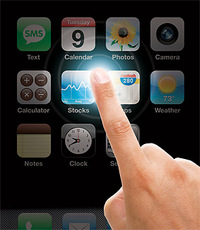“Touch” is the new paradigm

Writing in TIME magazine, Lev Grossman talks about the new paradigm of touch in one of the most compelling tech articles I’ve read this year:
“The two best demos I’ve seen this year were from
two very different companies, Apple and Microsoft, and oddly enough,
they were in many ways demos of the same product. One is a gimme: the
iPhone, Apple’s brilliant deconstruction of the common cell phone, due
out June 29. The other is a product mysteriously code-named Milan, from
a new branch of Microsoft called, not much less mysteriously, surface
computing. What the two have in common is a very advanced touch screen.”
As Grossman explains, the Apple iPhone completely changes our notion of what touch screens are supposed to do:
“We’ve
been conditioned to hate touch screens; we’ve all spent way too much
time timidly caressing tiny laptop trackpads and jabbing fingers at the
grubby, unresponsive touch screens on ATMs. But the iPhone’s screen is
another animal altogether. It’s extremely sensitive, like a trackpad,
but not oversensitive. There’s software in there designed to filter out
inadvertent touches, interpret gestures and anticipate what you’re
groping for. Unlike a trackpad, which goes berserk if you try to touch
it in two places at once, the iPhone’s touch screen can handle multiple
touches… The iPhone takes the
graphical-user interface–the GUI, in the parlance, pronounced
“gooey”–a step further and makes it a tactile user interface. You’re
viewing a little world where data are objects, and instead of just
pressing your nose up against the glass, you can reach in and pinch and
touch those bits and bytes with your hands. The word is made flesh. Any
realer and it would be Tron.”
What’s fascinating is that Microsoft seems to have stumbled on the same idea, but via a completely different type of technology:
“Imagine
an iPhone the size of a coffee table, and you’ll have some idea of what
Microsoft has been working on for the past five years. Milan is, in
fact, a table, with a large touch screen for a tabletop; the format
will remind the nostalgic among you of the old cocktail-style arcade
games. Like the iPhone, Milan’s screen can accommodate multiple touches
at once. My first reaction was that I was looking at a patent death
match in the making, but the underlying mechanisms turn out to be very
different
: Milan uses a system of infrared cameras to keep track of
where your fingers are, whereas the iPhone senses your fingers’
electrical properties.”
With Microsoft and Apple leading the way, what’s next for the technology industry?
“Touch screens are unlikely to stop there. They’re
just too useful. Once you use an iPhone, you’ll get twitchy fingers.
You’ll wonder why you can’t swipe your finger across your laptop screen
to jump backward and forward in your browser. The touchability exposes
the mouse as the crude finger substitute that it really is. Look at the
success of Nintendo’s Wii, which works on the same principle,
converting physical movements into virtual ones. People are ready to
break the fourth wall of computing and put their fingers directly on
the data. This is manual-free computing, instinctive and intuitive,
with zero learning curve.”
What do you think — will 2007 be defined by the new “touch paradigm” created by the likes of Mr. Softee and Apple?
[image: TIME magazine]




